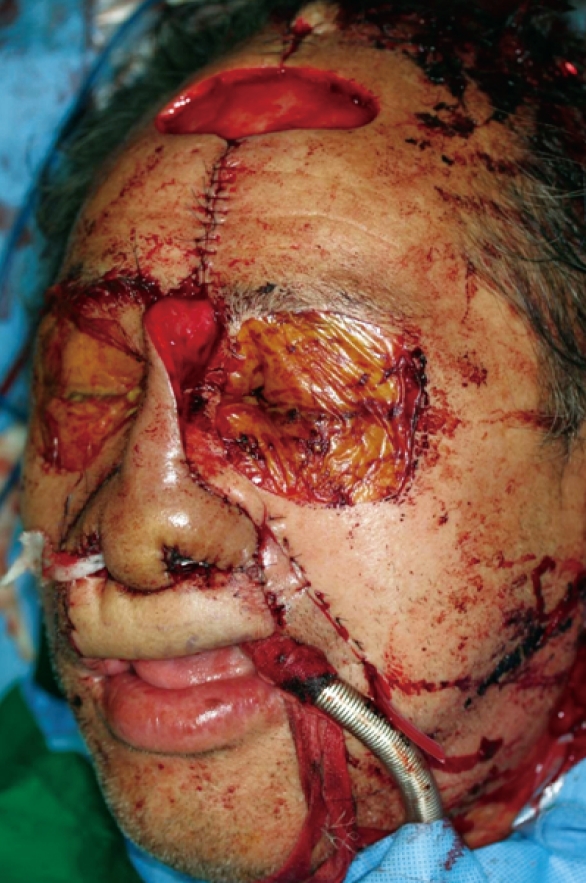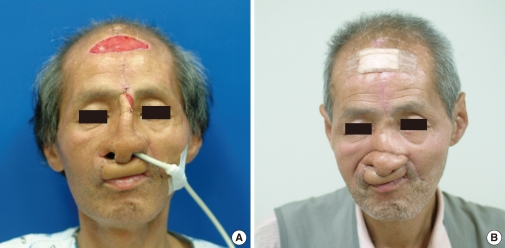Clin Exp Otorhinolaryngol.
2012 Mar;5(1):53-56.
One-Stage Reconstruction for Midfacial Defect after Radical Tumor Resection
- Affiliations
-
- 1Department of Otolaryngology-Head and Neck Surgery, Chung-Ang University College of Medicine, Seoul, Korea.
- 2Department of Plastic and Reconstructive Surgery, Chung-Ang University College of Medicine, Seoul, Korea. hkkiim@cau.ac.kr
Abstract
- A serious midface defect involving resection of squamous cell carcinoma originating from the hard palate was treated by an unusual reconstructive strategy. After tumor resection, surgical reconstruction was accomplished in one stage using one free flap with one distant and local flap: a radial forearm flap to reconstruct the upper lip, a forehead flap to reconstruct the external nose, a cantilever calvarial bone graft to replace the nasal skeleton and a nasolabial flap and split thickness skin graft to cover the internal nasal lining. The rationale for this one-stage reconstruction and the problems associated with midfacial reconstruction after wide tumor excision are discussed.
Keyword
MeSH Terms
Figure
Reference
-
1. Choung PH, Nam IW, Kim KS. Vascularized cranial bone grafts for mandibular and maxillary reconstruction: the parietal osteofascial flap. J Craniomaxillofac Surg. 1991; 8. 19(6):235–242. PMID: 1939669.2. Clauser L, Curioni C, Spanio S. The use of the temporalis muscle flap in facial and craniofacial reconstructive surgery: a review of 182 cases. J Craniomaxillofac Surg. 1995; 8. 23(4):203–214. PMID: 7560105.
Article3. Muzaffar AR, Adams WP Jr, Hartog JM, Rohrich RJ, Byrd HS. Maxillary reconstruction: functional and aesthetic considerations. Plast Reconstr Surg. 1999; 12. 104(7):2172–2183. PMID: 11149786.
Article4. Smolka W, Iizuka T. Surgical reconstruction of maxilla and midface: clinical outcome and factors relating to postoperative complications. J Craniomaxillofac Surg. 2005; 2. 33(1):1–7. PMID: 15694142.
Article5. Reece GP, Lemon JC, Jacob RF, Taylor TD, Weber RS, Garden AS. Total midface reconstruction after radical tumor resection: a case report and overview of the problem. Ann Plast Surg. 1996; 5. 36(5):551–557. PMID: 8743668.6. Nisanci M, Turegun M, Er E, Sengezer M. Reconstruction of the middle and lower face with three simultaneous free flaps: combined use of bilateral fibular flaps for maxillomandibular reconstruction. Ann Plast Surg. 2003; 9. 51(3):301–307. PMID: 12966244.7. Terz JJ, Young HF, Lawrence W Jr. Combined craniofacial resection for locally advanced carcinoma of the head and neck II: carcinoma of the paranasal sinuses. Am J Surg. 1980; 11. 140(5):618–624. PMID: 7435819.8. Martin JW, Lemon JC, King GE. Axillofacial restoration after tumor ablation. Clin Plast Surg. 1994; 1. 21(1):87–96. PMID: 8112016.9. Thomas WO, Harris CN. Subtotal midfacial/total nasal reconstruction following shotgun blast to the face employing composite microvascular serratus anterior rib, muscle, and scapular tip. Ann Plast Surg. 1997; 3. 38(3):291–295. PMID: 9088470.
Article10. Nothdurft FP, Propson M, Spitzer WJ, Pospiech PR. Implant-borne prosthesis for an edentulous maxilla with a large maxillectomy defect: a step-wise therapy concept. Schweiz Monatsschr Zahnmed. 2008; 118(9):827–842. PMID: 18846976.
- Full Text Links
- Actions
-
Cited
- CITED
-
- Close
- Share
- Similar articles
-
- The Clinical Outcome of Flap Coverage for the Treatment of Malignant Melanoma
- Reconstruction of Complex Zygomatico-Maxillary Defect Using the Free Vascularized Cutaneous Flap and Autogeneous Bone Graft: Case Report
- Treatment of fibrous dysplasia of the zygomaticomaxillary complex with radical resection and three-dimensional reconstruction with autologous calvarial bone graft
- Reconstruction of Midfacial Defect With Radial Forearm Free Flap
- Resurfacing defects from mycobacterial skin and soft tissue infections using thoracodorsal artery perforator free flaps





